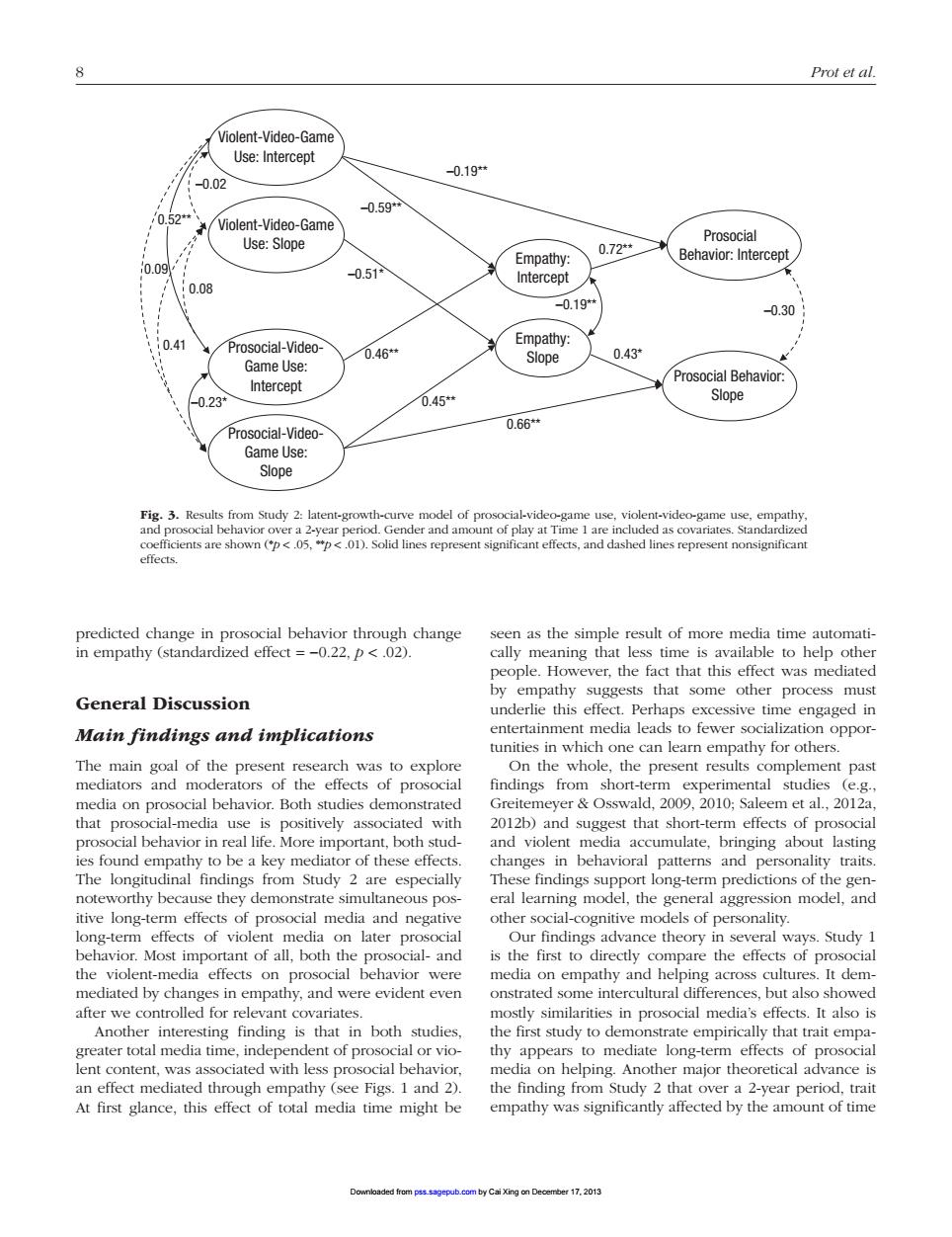正在加载图片...

8 Prot et al. Violent-Viden-Game Use:Intercept 0.02 -0.19 -0.59 Violent-Video-Game Jse:Slope 0.72 rcept 05 0.08 019* 0.3 0.41 Prosocial-Video- 0.43 Game Use 046* g Prosocial Behavio Intercept 045 Slope Prosocial-Video 0.66 Game Use: Slope Fig..om ve mo use,violent-vide-game. l behavior through change ple result of more people.However,the fact that this effect was mediated General Discussion by empathy suggests that some other process mus e this s effect.F ps excessive time engaged in Main findings and implications The main goal of the present research was to explore On the whole,the present results complement past mediators and moderators of the effects of prosocial media prosocia avior.Both studies demonstrated findings from short-temrmsdes about lastin changes in behavioral patterns and personality traits The longitudinal findings from Study 2 are especially These findings support long-term predictions of the gen e they demonstrate simult eral learing model.the genera aggre on model,and tive me the ersonalit Study is the first to directly compare the effects of prosocial the behavior were media on empathy and helping across culture t dem in empathy,and were evident even es. also sh hat in both studies n pros me thy appears to mediate long-term effects of prosocial media on helping.Another major theoretical advance is thr e Figs.I 2 e ing from tud ove ntly ected by 208 Prot et al. predicted change in prosocial behavior through change in empathy (standardized effect = −0.22, p < .02). General Discussion Main findings and implications The main goal of the present research was to explore mediators and moderators of the effects of prosocial media on prosocial behavior. Both studies demonstrated that prosocial-media use is positively associated with prosocial behavior in real life. More important, both studies found empathy to be a key mediator of these effects. The longitudinal findings from Study 2 are especially noteworthy because they demonstrate simultaneous positive long-term effects of prosocial media and negative long-term effects of violent media on later prosocial behavior. Most important of all, both the prosocial- and the violent-media effects on prosocial behavior were mediated by changes in empathy, and were evident even after we controlled for relevant covariates. Another interesting finding is that in both studies, greater total media time, independent of prosocial or violent content, was associated with less prosocial behavior, an effect mediated through empathy (see Figs. 1 and 2). At first glance, this effect of total media time might be seen as the simple result of more media time automatically meaning that less time is available to help other people. However, the fact that this effect was mediated by empathy suggests that some other process must underlie this effect. Perhaps excessive time engaged in entertainment media leads to fewer socialization opportunities in which one can learn empathy for others. On the whole, the present results complement past findings from short-term experimental studies (e.g., Greitemeyer & Osswald, 2009, 2010; Saleem et al., 2012a, 2012b) and suggest that short-term effects of prosocial and violent media accumulate, bringing about lasting changes in behavioral patterns and personality traits. These findings support long-term predictions of the general learning model, the general aggression model, and other social-cognitive models of personality. Our findings advance theory in several ways. Study 1 is the first to directly compare the effects of prosocial media on empathy and helping across cultures. It demonstrated some intercultural differences, but also showed mostly similarities in prosocial media’s effects. It also is the first study to demonstrate empirically that trait empathy appears to mediate long-term effects of prosocial media on helping. Another major theoretical advance is the finding from Study 2 that over a 2-year period, trait empathy was significantly affected by the amount of time Prosocial Behavior: Intercept Empathy: Intercept Empathy: Slope 0.66** 0.43* 0.45** –0.30 0.46** –0.59** –0.19** –0.51* 0.72** –0.19** –0.02 –0.23* 0.41 0.09 0.08 Violent-Video-Game Use: Intercept Violent-Video-Game Use: Slope Prosocial-VideoGame Use: Intercept Prosocial-VideoGame Use: Slope Prosocial Behavior: Slope 0.52** Fig. 3. Results from Study 2: latent-growth-curve model of prosocial-video-game use, violent-video-game use, empathy, and prosocial behavior over a 2-year period. Gender and amount of play at Time 1 are included as covariates. Standardized coefficients are shown (*p < .05, **p < .01). Solid lines represent significant effects, and dashed lines represent nonsignificant effects. Downloaded from pss.sagepub.com by Cai Xing on December 17, 2013